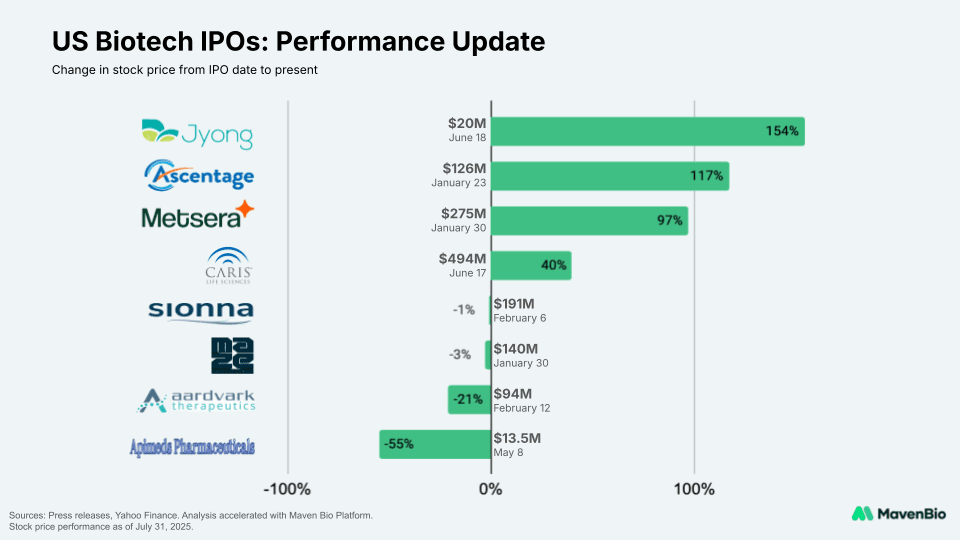
US Biotech IPOs: H1 2025 Performance Update
August 06, 2025
Only eight biotech companies have gone public thus far in 2025, marking a multi-year low. Investor enthusiasm remains cautious amid uncertainty surrounding FDA regulation and drug pricing policy, contributing to a roughly 4.5% YTD decline in the XBI. Despite these challenges, certain stocks have significantly outperformed the broader sector.

Ascentage had a 117% increase, driven by CDE Breakthrough Therapy designation for olverembatinib in first-line Philadelphia chromosome-positive acute lymphoblastic leukemia (Ph+ ALL). JPMorgan’s subsequent "Overweight" rating and compelling June clinical data from ASCO and EHA across olverembatinib, BCL-2 inhibitor lisaftoclax, and MDM2 antagonist alrizomadlin supported the stock.
Olverembatinib achieved a 100% ORR and 97% complete remission rate in a Phase II combination trial for Ph+ ALL, with 89% of patients attaining complete molecular response within three treatment cycles. Lisaftoclax became the first BCL-2 inhibitor demonstrating meaningful efficacy after venetoclax failure, showing a 31.8% ORR in venetoclax-refractory AML and MPAL patients. Current salvage therapies typically have response rates near 20% with median overall survival of 2-3 months; lisaftoclax's superior efficacy represents a notable advance, particularly in TP53-mutant cases.
Metsera jumped 97% following its $275M IPO, driven by excitement around the obesity therapy market. Its lead candidate, MET-233i, an ultra-long-acting amylin analog with a unique mechanism, delivered promising Phase 1 results in June, showing 8.4% placebo-adjusted weight reduction within 36 days. Upcoming milestones include the release of 12-week monotherapy data and results from the VESPER-3 combination trial later this year, alongside the initiation of Phase 3 trials for MET-097i, Metsera’s GLP-1 analog.
Caris gained nearly 40% after a $494 million IPO, fueled by strong investor interest in its AI-powered precision oncology platform. FDA approval of MI Cancer Seek, a first-in-class companion diagnostic assay that integrates whole-exome and whole-transcriptome sequencing, underscores Caris’s technological leadership and contributed to a 50% YoY revenue increase. Near-term catalysts include ongoing commercial expansion, broader payer coverage of MI Cancer Seek, potential label expansions for additional CDx indications, and updates to Caris Assure, the company's liquid biopsy program.
Jyong surged 154%, although from a smaller IPO base. Its lead botanical therapy for BPH, MCS-2, is restarting a U.S. Phase 3 trial. Competing against established α-1 blockers and 5-ARIs, Jyong must demonstrate superior safety to establish market traction.
Aardvark declined by 21%. Its primary candidate, ARD-101, remains in the Phase 3 HERO trial, a 90-patient double-blind study targeting hyperphagia in Prader-Willi syndrome. However, the approval of Soleno’s Vykat XR earlier this year has raised the clinical efficacy benchmark.
Maze held steady as significant catalysts for its Phase 2 chronic kidney disease asset, the APOL1 inhibitor MZE829, remain distant, with proof-of-concept results not anticipated until early 2026. Investor sentiment was negatively impacted when the FTC blocked Maze’s initial licensing agreement with Sanofi for Pompe disease, shifting commercial rights to Shionogi, a firm lacking Sanofi’s established commercial infrastructure.
Unlock purpose-built AI research for your team
Stop burning hours on manual data hunts — let Maven Bio do the heavy lifting so you can focus on the strategic decisions that drive your business forward.
Schedule a Demo